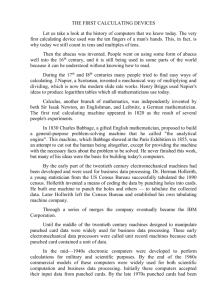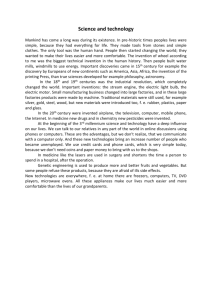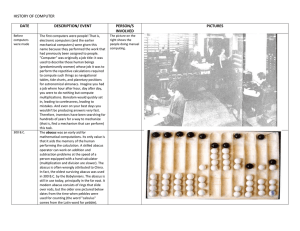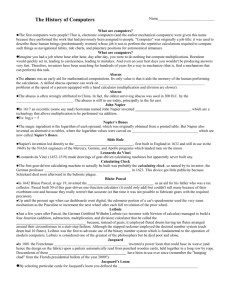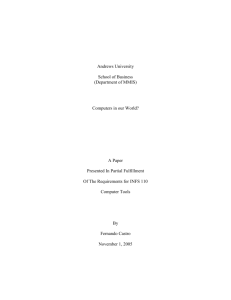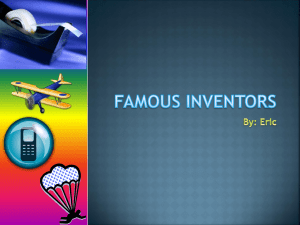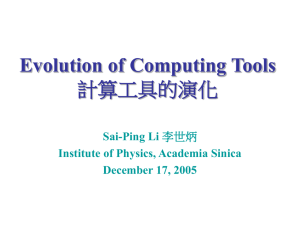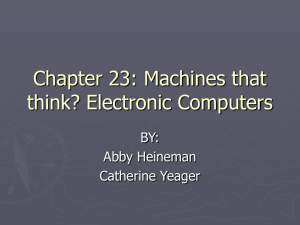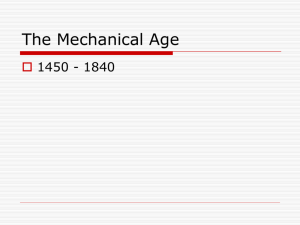History of Educational Technology-Machines
advertisement
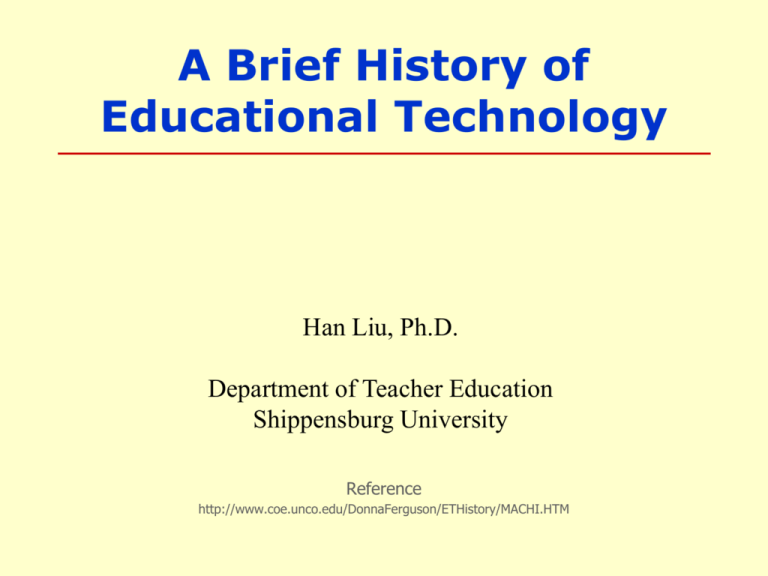
A Brief History of Educational Technology Han Liu, Ph.D. Department of Teacher Education Shippensburg University Reference http://www.coe.unco.edu/DonnaFerguson/ETHistory/MACHI.HTM Abacus • The invention of the abacus in 3,000 BC marked the beginning of computers. • For the first time, people had a calculating device with which to do math. Saun-Pan and Soroban • The earliest surviving counting board is the Salamis Tablet which dates back to 400 BC. China (Saun-pan) and Japan (Soroban) introduced computer trays at about the same point in history (200 AD). The Soroban (a type of abacus), in particular, is still used today for calculating. Abacus • Abacus( Babylonian 3000 B.C.) • Saun Pan (China) • Soroban (Japan) Stonehenge • Around 2,300 BC the creators of Stonehenge first began work on what is now known as an astronomical calculator. This miraculous complex took over 2,000 years to complete. • Stonehenge stands on Salisbury Plain, two miles west of the town of Amesbury, Wiltshire, in Southern England. Pictures of Stonehenge Leonardo da Vinci Calculator In 1452 AD it is believed that Leonardo da Vinci conceived of a calculation device. Guttenburg Printing Press • Johannes Gutenberg (Germany) developed the printing press, sometimes considered the greatest invention of all time. • Between 1452 and 1456, Gutenberg printed the first book ever, the Bible. Guttenburg Printing Press Napier’s Bones • John Napier, the inventor of logarithms, created an aid to calculation known as 'Napier's Bones' in 1617. • He described a method of multiplication using "numbering rods" with numbers marked off on them. Napier's numbering rods were made of ivory, so that they looked like bones. This explains why they are now known as Napier's bones. To multiply numbers, the bones were placed side by side and the appropriate products read off. Napier's Bones Slide Rule • Robert Bissaker first created the slide rule in 1654, an instrument used by engineers and scientists until the 1970s. • The slide rule was a precursor to the electronic calculator. Slide Rule Magin Cataoprica • The Magin Catacoprica or magic lantern, invented in 1646, led to the eventual zoetrope. • Magic lantern, or slide, shows played an important role, attracting young and old to schools, theaters, and homes to watch depictions of fables, legends, and current events. The magic lanterns projected hand-painted or photographic glass slides, which were inserted into the projector one at a time for small audiences to view together. A skilled projectionist could move them quickly, making the screen images appear to move. Magin Cataoprica 1700s Invention Jacquard Loom • In 1725, Joseph-Marie Jacquard (French) invented a way to weave silk using punched cards. These punched cards would become the predecessors of those used in the first computers. • The idea of using punched cards to control machines was considered to be the birth of modern day computer programming. Jacquard Loom Benjamin Franklin-Electricity • Benjamin Franklin discovered by when he flew his kite one stormy day in June, 1752. This discovery would eventually allow us to power the computers we have come to rely on so heavily in our modern society. Benjamin Franklin 1800s Invention • The 1800s brought about the advent of the first calculating machines invented by Leibniz and produced in large numbers. Calculating Machine Babbage • Charles Babbage's calculating engines (1822) are among the most celebrated icons in the prehistory of computing. • Babbage is often considered the "Grandfather of Modern Digital Computing". • He was the first person to realize that a computing machine must be composed of – – – – input device (the card reader) memory (the store), central processing unit (the mill), and output device (the printer). Charles Babbage’s calculating engine Motion Pictures • Peter Mark Roget, 1824, first envisioned motion pictures. • In 1912 the Victor Animatograph Company produced the first portable lantern-slide projector and 16 mm projector. Telephone • In1876, Alexander Graham Bell invented the electrical speech machine which we now call the telephone. This machine would one day make distance learning and the Internet possible. Bell Telephone Hollerth and IBM • Hollerith, in 1884, applied for a patent for his automatic punch-card tabulating machine and then in the 1890s he developed an electromechanical machine to help with the US census. • Hollerith's tabulator became so successful that he started his own business (Tabulating Machine Company) to market the device. This company eventually became International Business Machines (IBM). Hollerith's Tabulator Thomas Edison’s Inventions • In the late 1800s Thomas Edison invented the Kinetoscope, disk phonograph, and electric light bulb. Wireless Communication: Radio • In 1895, Guglielmo Marconi successfully sent signals using electromagnetic waves between a transmitter and a receiving antenna. Radio Transmission Distance Education • During the late 1800s distance education was first introduced by Issac Pittman in England. • Distance university study began in America in 1874 at Illinois Wesleyan University at both the graduate and undergraduate levels. A Correspondence University was also founded in Ithica, New York in 1883. • Today interactive television, computer based E-Mail and conferencing, as well as exchange of messages by audio and video tape are the norm. 1900s’ invention • As the 1900s come to an end, it is impressive to view the advances that have occurred during this century. Educational Film • The earliest forerunners of the educational film were the newsreel, travelogue, and the scientific motion picture. • In 1902 Charles Urban exhibited films which showed the growth of plants, emergence of a butterfly, and undersea views. These films are thought to be the first educational films. • Thomas Edison was one of the first to produce films for classrooms. 16 mm Projector • In 1912, the first experimental telephonic broadcast was conducted in the Physics Department of the University of Wisconsin. This year also saw the introduction of 16 mm projectors. Educational Radio • It is believed that the oldest educational radio station is WHA, owned by the state of Wisconsin and operated by the University of Wisconsin since 1917. Television • The first public demonstration on television was conducted in 1927. • The birth of the electronic television age is almost impossible to pinpoint exactly. • Due to the numerous contributors that helped to develop this new medium, it is even more difficult to acknowledge any one person for its invention. Differential Analyzer • Bush, Vannevar (1890-1974), an American scientist. From 1919 to 1971 Bush worked and taught at Massachusetts Institute of Technology (MIT) where he invented the differential analyzer, a forerunner to the modern computer. Differential Analyzer • Turing Machne • Turing, a British Mathematician, often known as the founder of computer science, developed the Turing machine in 1936. • Turing's Machine is the cornerstone of the modern theory of computation and computability even though it was invented nine years before the creation of the first electronic digital computer. ENIAC • In 1941 , the ENIAC computer was introduced. • ENIAC was unveiled in Philadelphia. It represented a stepping stone towards the true computer. • It was built out of some 17,468 electronic vacuum tubes, ENIAC was in its time the largest single electronic apparatus in the world. ENIAC • 1950s’ Invention Educational Television Programs • Some accounts of the origin of classroom television mark May 25, 1953 as the day when KUHT in Houston, Texas began broadcasting. Others point to commercial programs beamed into homes early in the morning, such as the Continental Classroom. Sputnik • On October 4, 1957, the former Soviet Union successfully launched Sputnik I. The world's first artificial satellite was about the size of a basketball, weighed only 183 pounds, and took about 98 minutes to orbit the Earth on its elliptical path. Programmed Instruction • In 1957, programmed instruction materials based on Skinner’s behaviorism are used at the Mystic School in Massachusetts Integrated Circuits • 1958,Texas Instruments began manufacturing integrated circuits on one piece of silicon. COBOL Language • 1960 Common Business Oriented Language (COBOL) was developed by a team drawn from several computer manufacturers and the Pentagon. • COBOL , the first packaged programs which were sold by the Computer Science Corporation. 1960s Inventions • The 1960s ushered in the era of computers in classrooms. Communication Satellites • In 1962, we saw the advent of communication satellites. Mouse • In 1963 CAD and Sketchpad were first introduced and a patent was received on the mouse pointing device. Mini-Computers • Mini-computers and BASIC were both introduced in 1964. The first Ph.D. of Computer Science • The first Ph.D. was awarded in computer science to Dr. Wexelblat at the University of Pennsylvania in 1965. PDP-8 in 1965 the First TRUE Minicomputer Floppy Disks • In 1967, IBM began producing floppy disks. 1970s Pocket Calculator • During 1972, three engineers from Texas Instruments, Kilby, Maryman and Van Tasel, invented the electronic pocket calculator. The First International Connections • In 1973, the first international connections were made to ARPANET The Internet • The Internet • In 1973, the U.S. Defense Advanced Research Projects Agency (DARPA) initiated a research program to investigate techniques and technologies for interlinking packet networks of various kinds. • In 1986, the U.S. National Science Foundation (NSF) initiated the development of the NSFNET which, today, provides a major backbone communication service for the Internet. 8800 Computer 1975 First Mass Produced and Marketed Personal Computer • By 1975 the market for the personal computer (PC) was demanding a product that did not require an electrical engineering background and thus the first mass produced and marketed personal computer (available both as a kit or assembled) was welcomed with open arms. MS DOS • 1975 saw the introduction of the MS DOS Operating System by Microsoft • PC/IBM -DOS was developed for IBM by Bill Gates. He retained the rights and later developed MS-DOS. MS-DOS was derived from Seattle Computer Products' 86-QDOS and renamed DOS v.1.0 in 1981 Bill Gates Apple Formed in 1977 • 1977 microcomputers were placed in schools and Apple was formed. CAI • 1980s CAI: Computer-Assisted Instruction LOGO in 1980 • In 1980, Seymour Papert introduced LOGO, a constructivist programming tool for children. • It was the first language specifically designed to enable children to learn by discovery. Macintosh Computer • In 1984, Apple first introduced the Macintosh Computer. • The mouse and the icon became the major tools for computer interaction. 1990s • In 1990, Windows 3.01 was developed and networked systems were introduced. • During 1991, GOPHER and the World Wide Web (WWW) were released. • In 1992, Windows 3.1, the Pentium processor by Intel and Hewlett-Packard laser jet printers were all introduced. • In 1994, shopping malls arrived on the Internet, allowing a new method to shop at home. • 1995 saw the introduction of Windows '95. 1990s • • • • • • Video disks (VCD) CD-ROMs Multimedia DVD Teleconferencing Software-- 2000 to Present • • • • Virtual reality Online life Mobile computer lab Wireless Internet access Summary-1 From Blackboard to WWW • • • • Blackboard Slides-Projector (audio tape, video cassette…) PowerPoint WWW – – – – – Unlimited resources Equal accessibility (divide vs. equalizer) Instantaneously Simultaneously Multimedia Summary-2 From instructional tools for teachers to learning tools for students and teachers as well • Classroom without teachers • Programmed instruction • CAI: Computer-Aided Instruction • Web-based learning • NTeQ Model: Integrating Technology for Inquiry • Education theory vs. learning theory • • http://video.search.yahoo.com/ http://www.learner.org/resources/series176.html Summary-3 From the extension of human sense organs’ capacities to enhancement of human thinking and reasoning abilities • • • • • • • • • • • See more clearly Hear more distinctively Conduct more efficiently Physical brain & digital brain Multitasking Multidimensional thinking Active reasoning momentum Ownership of information resources Incidental learning opportunity Teacher and student learn from each other No limitation of time and place Future NTeQ Model Paperless classroom Bookless schoolbag
